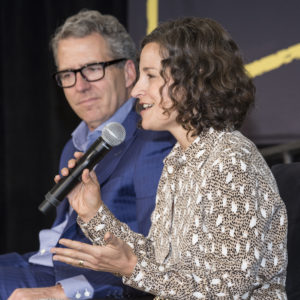How technology, education, diversity, and open innovation intersect with urban life: insights from Smart Cities NY.
Cities are one of humankind’s most remarkable inventions, and have served as test beds for innovation and progress throughout history. More than half of the world’s population live in urban areas today, and by 2050, the United Nations projects that two-thirds of us will live in cities.
We’ve been in the “smart cities” trenches with biothreat detection and non-traditional data, and conversations around urban life are increasingly connected to our work in other areas — from the future of health to the future of work.
Strategist Kate Machtiger, who leads design and insights at Luminary Labs, and Senior Analyst Mahala Pagán, who led the Hidden Signals Challenge, shared insights from the Smart Cities NY conference last month.
What is it, exactly, that makes a city “smart”?
Kate Machtiger: Smart cities use technology to dynamically connect with citizens to provide more efficient services and improved quality of life.
Mahala Pagán: Smart cities are applying technology to address common urban challenges — both immediate and emerging — to improve services, communication, and quality of life for all zip codes.
This year’s theme was “Powered by People.” Diversity and inclusion came up in conversations at the event. What’s the connection with smart cities?
KM: If you aren’t engaging with a wide range of populations across your city in an authentic way, your city will never truly be smart. Stupid cities focus on tech for tech’s sake, rolling out expensive programs without seeking input, collecting inhabitants’ data while giving nothing back. Smart cities support sustainable growth and optimize for the whole rather than a part — they are dynamic and constantly improving based on feedback from voices big and small.
MP: The emphasis on inclusion was almost synonymous with an emphasis on tech mindfulness, taking a balanced approach to innovation. It’s also a reminder to always question the notion of “optimization,” and really ask who you’re optimizing for, as well as who may suffer from this change.
Cities need to revolve around the needs of people rather than the needs of technology.
KM: We have learned from the past that cities need to revolve around the needs of people rather than the needs of technology. We’ve designed around technology before, and today we’re paying the price for that. In New York, Robert Moses architected great highways across historic neighborhoods and some of our — now precious, but at the time, wasted — waterfront. In his mind, “cities are created by and for traffic,” but this vision didn’t consider the needs of people. Today, the conversation is much more focused around creating vibrant street life, building corridors of interaction and innovation — but the Robert Moseses of the world still exist, and they’re trying to optimize cities around autonomous vehicles or sensor networks. This time we can be smarter, though, and assert that cities should be created by people who love living in cities, not people who want to optimize away all that is great about the messy intersections and close proximity of urban life.
MP: There was a lot of talk about inclusive economic growth, and how cities can make sure people aren’t left behind when emerging technologies and new ways of working create “winners and losers.” Along with technological innovation, we will need to continue investing in affordable housing, education, and other systems that will help prevent people from falling too far behind. Without underrepresented voices in the room, “smart cities” can quickly become “menacing cities” that accelerate inequality. Everyone can and should have an opportunity to shape the smart cities where they live.
What can other organizations learn from how cities approach innovation?
MP: About 95% of U.S. patents come out of its largest cities. So, when people quote former New York Mayor Ed Koch, who said “New York is where the future comes to audition,” it’s more than a catchy slogan.
KM: Cities are where big ideas fail and small ideas change the world. With all the technological advancement coming and so many visions for what the world could look like, many organizations are hesitant to put a stake in the ground, but what will actually differentiate you from your competitors is trying something and learning from it. This is how you iterate toward a sustainable product or service that creates real change. You can keep talking about the change that’s coming, or you can do something and quickly become the smartest one in the room on that topic because you have real results.
MP: Testing in cities requires a lot of bravery. As Sarah Hunter of Alphabet’s X explained, local governments can make or break a successful pilot, far more than the federal government can. We need urbanists with historical knowledge who can look at technology and future-proof urban planning with a critical eye, but we also need to balance this with optimism. If we look at these innovations through a lens that skews too negative, we will miss fantastic opportunities.
KM: Cities also show the dangers of one big idea taking hold without any real evidence it works. Le Corbusier’s ideal city became the template for New York’s public housing developments, but it had never been tested on any real people, let alone the population it was being deployed for — and of course it failed. It’s easier than it has ever been to gather input and test products or services before deploying them; any company that skips this phase will learn the hard way that sustainable ideas aren’t cooked up in a conference room, but are built over time through collaboration with experts, end users, and everyone in between.
The ‘move fast and break things’ approach doesn’t necessarily work for cities.
MP: The “move fast and break things” approach doesn’t necessarily work for cities. Prototyping with a community — even if it takes longer or adds complexity — is preferable to prototyping on a community. Transparency, especially when it comes to the collection and use of data, is important to the process. The team from NYC Mayor’s Office of Data and Analytics spoke about the need for the intentional use of analytics: identifying and understanding the critical assumptions behind every datapoint that informs policy decisions. UNICEF’s Jennie Bernstein advocated for “data philanthropy” and said corporations should be generous about sharing data that could have a social impact.
We’ve seen increasing interest in open innovation at the city level. How are cities using challenges, crowdsourcing, and other open innovation programs?
MP: As Civic Consulting USA’s Alexander Shermansong explained, existing government procurement processes aren’t conducive to innovation. Whether buying software or toilet paper, many cities require the same lengthy procurement process (which can sometimes take up to 26 months). In some cases, the procurement cycle is longer than the lifetime of a startup, and more generally, it doesn’t match up with the way startups and other fast-moving businesses operate. While government procurement requires you to specify the product you want, open innovation specifies the problem to be solved. Solving for problems rather than product specs creates opportunities to identify novel solutions in a shorter amount of time.
KM: Open innovation and crowdsourcing can outperform existing systems when it comes to sourcing information, ideas, and new products — and also have the added benefit of engaging citizens and communities in a tangible way, giving people a say in how their city changes. The best uses involve understanding exactly what the public can bring to a problem space and designing a challenge or project that brings their unique input, skills, and energy to bear on relevant issues that need a fresh perspective.
MP: This is where open innovation programs like NYCx’s Moonshot and Co-Lab Challenges come in — and as we heard from Youssef Kalad and Jose Serrano-McClain, they’ve asked NYC some big questions. The Moonshot Challenge asked how we might replace all gas-powered vehicles in NYC. The Co-Lab Challenge asked how we might encourage more people to enjoy, navigate, and use Brownsville’s public spaces at night and how we might get to zero waste and litter and increase recycling in Brownsville’s public housing.

Luminary Labs CEO Sara Holoubek spoke at Smart Cities NY. Watch video of the panel discussion.
Luminary Labs CEO Sara Holoubek was part of a panel discussion at Smart Cities NY about preparing the workforce of the future. What’s the connection between smart cities and the future of work and education?
MP: Kristen Titus, the chief technology and innovation officer for New York State, said an estimated 40% of today’s Fortune 500 companies won’t exist in 10 years, and 65% of today’s students will have jobs yet to be invented, so we need responsive infrastructure to support the economy’s evolving demands.
KM: Kristen was the founding director of NYC Tech Talent Pipeline, a technology education and workforce initiative that worked with public and private sector partners. Other organizations here in New York are approaching that problem from different angles. Mouse is a youth development nonprofit that’s helping kids from underserved communities connect with creative STEM education. Code/Interactive is training educators in computer science as part of an effort to bring more diversity to the tech industry. Cities are a natural place for these initiatives, because educators and employers benefit from close proximity. Opportunity is often linked with access.
MP: Connecting technical education pathways to actual industry needs and skills gaps has never been more important — and it requires industry and education to speak the same language. New Lab’s Shaina Horowitz reminded us that it’s not enough to set up career pathways; educators should connect with companies to make sure technical education programs focus on the skills needed today and tomorrow. Leading by example, the Brooklyn Navy Yard — home to New Lab and other businesses spanning manufacturing, technology, food, fashion, and media — is partnering with the Brooklyn S.T.E.A.M. Center on New York City’s first public school Career and Technical Education (CTE) program to be co-located within a business environment.
The Lab Report helps executives make sense of emerging trends and new opportunities. Sign up for the newsletter, and we’ll send insights straight to your inbox.
Photo by NASA on Unsplash.


